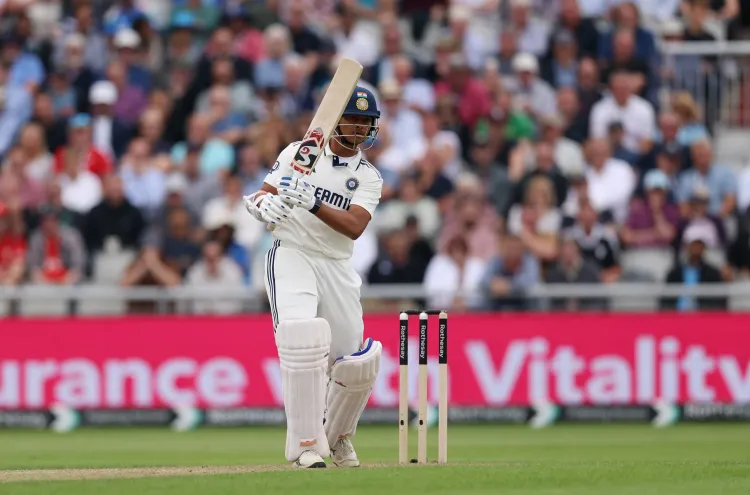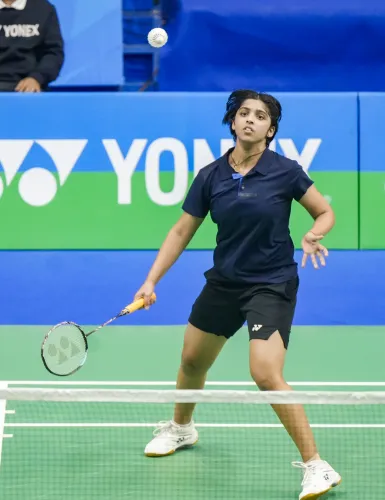Is Standing on the Crease in a Five-Day Match a Big Deal? Insights from Yograj Singh

Synopsis
Key Takeaways
- Batting discipline is essential for Test success.
- KL Rahul and Yashasvi Jaiswal demonstrated commendable resilience.
- Ravindra Jadeja could play a key role in the batting order.
- Strengthening India’s tail can make a significant difference.
- Consistent practice is crucial for developing all-rounders.
Chandigarh, July 23 (NationPress) The Indian opening pair of KL Rahul and Yashasvi Jaiswal exhibited a level of batting discipline that is uncommon in today's game — a quality that has earned accolades from former Indian cricketer Yograj Singh. He asserts that the long-term success of the team in Test cricket hinges on resilience at the top and strength at the bottom.
“To stand on the crease during a five-day match is a significant accomplishment — and this is a lesson current players must internalize, especially given their backgrounds in T20s and ODIs,” Yograj Singh shared with IANS in a recent interview. “Today, KL Rahul and Yashasvi Jaiswal have exemplified that discipline.”
After being asked to bat first by Ben Stokes, India reached lunch at an impressive 78 for no loss in 26 overs, unscathed and brimming with confidence. Rahul was not out on 40 from 82 balls, remaining calm and collected, while Jaiswal restrained his natural aggression to score 36 not out from 74 balls. This session was one that traditional Test enthusiasts would wholeheartedly endorse — it was marked by hard work, patience, and attrition.
Despite the English bowlers generating significant movement and bounce, Rahul and Jaiswal demonstrated exceptional precision in their leave and defended their stumps with clarity. “I believe KL Rahul has made considerable improvements. His head-on coordination is impressive,” Yograj commented. “And Jaiswal has addressed a critical flaw — his habit of playing hook and pull shots with a dropping shoulder. Today, his batting appeared solid.”
Chris Woakes troubled Jaiswal with multiple deliveries that beat the outside edge but failed to secure a breakthrough. Conversely, Jaiswal managed to strike three boundaries off Woakes, while Rahul found the boundary twice. When Brydon Carse was introduced into the attack, Rahul dispatched him for two boundaries, and Jaiswal skillfully found the gap between the third slip and gully.
Rahul also surpassed the 400-run milestone in the series and faced a significant portion of Jofra Archer’s fiery spell — a noteworthy point considering Archer had dismissed Jaiswal in both innings at Lord’s. Jaiswal had a stroke of luck when an outside edge off Archer sped past slip, and later electrified the Old Trafford crowd with a six off Ben Stokes.
For Yograj Singh, the initial resistance exhibited by the Indian openers was not just commendable — it symbolized how India's red-ball strategy should progress. Reflecting on his own playing days, he recounted a pivotal moment in his career. “Our captain advised me, ‘You shouldn’t be batting at No. 7 when you’re scoring 70s and 80s.’ I opened and scored 137. It’s essential to trust your instincts and elevate such players.”
With this in mind, Yograj suggests that India should rethink their top-order strategy, especially with someone like Ravindra Jadeja in form. “Jadeja can fit in at No. 3, No. 4, or No. 5. He’s performing well — grant him that responsibility.”
However, the former fast bowler didn’t stop there. His most fervent recommendation was to bolster India’s tail, which has often proven to be a game-changer in foreign conditions. “How many times have I emphasized this? Train your tailenders — your bowlers — to bat for two hours. Zaheer Khan, Harbhajan Singh, and even Bumrah have shown they can wield the bat,” Yograj passionately declared. “The more all-rounders you cultivate, the more robust your team becomes.”
Indeed, India’s lower order has rescued the team on numerous occasions recently. Yograj stressed that consistent practice is crucial. “You need to transform your bowlers into all-rounders. Allocate time for batting — let them face the bowling machine. Encourage batters to bowl to bowlers. Foster that culture in the nets.”










